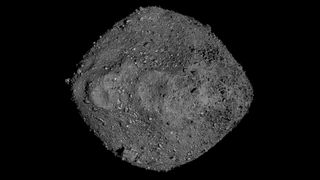Asteroid Bennu nearly swallowed up NASA's sampling spacecraft
It was a close call, but OSIRIS-REx's unexpected adventure might help improve planetary defense techniques.

NASA's asteroid-sampling spacecraft had a near-death experience at Bennu, according to the mission team.
In October 2020, the agency's OSIRIS-REx spacecraft nearly sank into the surface of the rubbly asteroid while picking up rocks for shipment to Earth in 2023, team members revealed Thursday (July 7). The spacecraft only escaped getting stuck or sinking into oblivion within Bennu by firing its thrusters at the right moment.
"We expected the surface to be pretty rigid," principal investigator Dante Lauretta, a planetary scientist at the University of Arizona, told Space.com. "We saw a giant wall of debris flying away from the sample site. For spacecraft operators, it was really frightening."
Read more: Dramatic sampling shows asteroid Bennu is nothing like scientists expected
Related: Ride shotgun with NASA's OSIRIS-REx asteroid probe as it buzzes Bennu (video)
Now that the spacecraft (more formally known as Origins, Spectral Interpretation, Resource Identification, Security-Regolith Explorer) is safely on its way back to our planet to deliver its precious cargo, scientists are digging into the science implications of the dramatic moment.
"It turns out that the particles making up Bennu's exterior are so loosely packed and lightly bound to each other that they act more like a fluid than a solid," Lauretta said in a University of Arizona statement.
That structure is why the OSIRIS-REx sampling probe had such a close call, he and his colleagues determined. The loose surface, made up of particles jostling against each other like plastic balls in a children's play area, has implications for how asteroids were formed and also for planetary defense techniques to protect against potential rogue space rocks coming near our planet, NASA added in a second statement.
Get the Space.com Newsletter
Breaking space news, the latest updates on rocket launches, skywatching events and more!
Photographs from the mission showed a giraffe-scale crater left behind from the brief touchdown, scarring the surface as far as 26 feet (8-meters) wide. That was nothing like the small divot investigators predicted from simulations.
The encounter was a very close call for the spacecraft, mission personnel now say. Where scientists had expected to find a firm surface, the spacecraft experienced resistance comparable to that needed to filter a French press coffee maker, they said.
"By the time we fired our thrusters to leave the surface, we were still plunging into the asteroid," Ron Ballouz, an OSIRIS-REx scientist based at the Johns Hopkins Applied Physics Laboratory in Maryland, said in the University of Arizona statement.
"I think we're still at the beginning of understanding what these bodies are, because they behave in very counterintuitive ways," Patrick Michel, an OSIRIS-REx team member and asteroid scientist at Côte d'Azur Observatory in France, said in the NASA statement.
Space.com senior writer Tereza Pultarova contributed reporting to this story. Follow Elizabeth Howell on Twitter @howellspace. Follow us on Twitter @Spacedotcom and on Facebook.
Join our Space Forums to keep talking space on the latest missions, night sky and more! And if you have a news tip, correction or comment, let us know at: community@space.com.

Elizabeth Howell (she/her), Ph.D., is a staff writer in the spaceflight channel since 2022 covering diversity, education and gaming as well. She was contributing writer for Space.com for 10 years before joining full-time. Elizabeth's reporting includes multiple exclusives with the White House and Office of the Vice-President of the United States, an exclusive conversation with aspiring space tourist (and NSYNC bassist) Lance Bass, speaking several times with the International Space Station, witnessing five human spaceflight launches on two continents, flying parabolic, working inside a spacesuit, and participating in a simulated Mars mission. Her latest book, "Why Am I Taller?", is co-written with astronaut Dave Williams. Elizabeth holds a Ph.D. and M.Sc. in Space Studies from the University of North Dakota, a Bachelor of Journalism from Canada's Carleton University and a Bachelor of History from Canada's Athabasca University. Elizabeth is also a post-secondary instructor in communications and science at several institutions since 2015; her experience includes developing and teaching an astronomy course at Canada's Algonquin College (with Indigenous content as well) to more than 1,000 students since 2020. Elizabeth first got interested in space after watching the movie Apollo 13 in 1996, and still wants to be an astronaut someday. Mastodon: https://qoto.org/@howellspace
